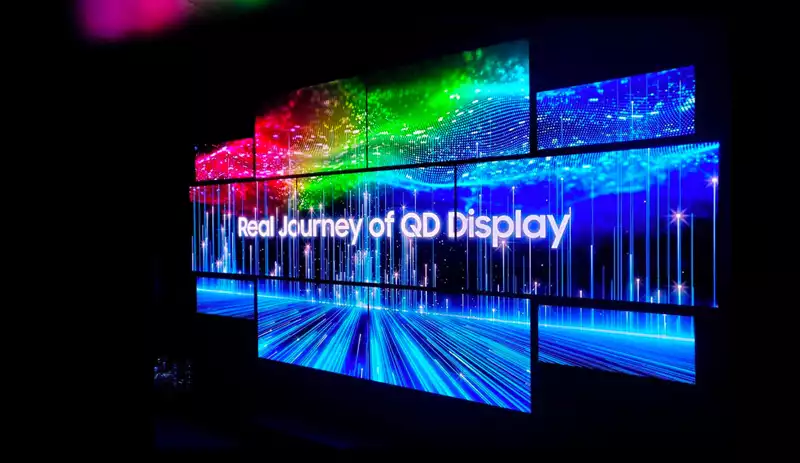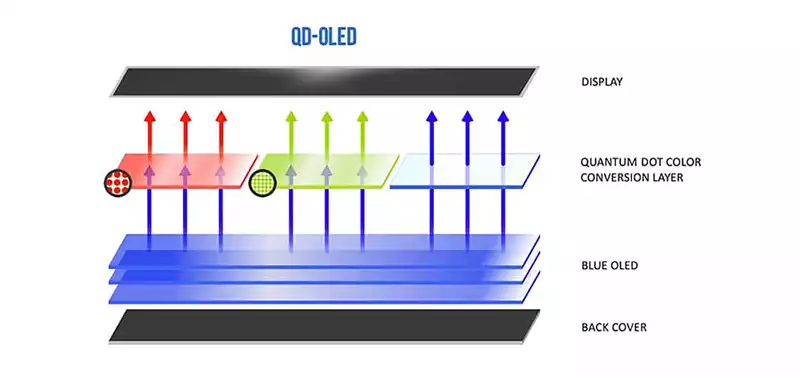You can also be interested in these:
- Samsung Neo QLED TVs and Quantum Matrix technology
- What are the Samsung KS8000 best settings?
- Full honest Samsung Galaxy Tab A6 review
- Google Pixel 6 will copy Samsung Galaxy S21 features
Samsung just released a revolutionary screen display that could put the two current competing technologies out of work, just as VHS did to Betamax and DVD did to Laserdisc, it’s called Samsung QD-OLED technology. So, could Samsung QD-OLED technology really take out the two current contenders, which are Quantum Dot LED (QLED TV) and Organic LED (OLED TV)?

Follow along as I take you through the new QD-OLED technology and why you’ll be seeing it in your new TVs soon.
What is Samsung QD-OLED technology?
Both QLED TV and OLED TV have benefits and drawbacks, which you generally need to decide what your preference is, what you’re going to be watching, and even where you’ll watch it. However, Samsung decided you shouldn’t have to choose and has combined the two technologies to create something new and better.

With Samsung QD-OLED technology, you get all the benefits, including vivid colors, high peak brightness with no light bleed, wide viewing angles, and perfect deep blacks.
So if this new technology can deliver it all, then would it really make sense for you to choose between the older technologies and get poorer performance?
How does Samsung QD-OLED technology work?
Samsung has taken standard OLED technology and enhanced it by improving how much light a single OLED pixel can produce and removed the color filter that standard OLED TVs have. This gives the QD-OLED superior brightness and clearer colors.
Samsung then takes the idea from QLED technology of using a pure blue background material with their quantum dot technology and then splitting the pixels into three colors, a pure blue subpixel which is the original blue material unchanged, a red subpixel, and a green subpixel. This allows true RGB colors, and with quantum dot technology being so energy efficient, there is no brightness lost and no need for a color filter.

QD-OLED technology also has three layers of blue OLED material which allows it to spread the energy requirements across those layers when increasing brightness. The big benefit of doing this is that other OLED screens will burn out faster as you increase brightness due to the power requirements. However, with the power requirements being spread out, the QD-OLED screens should last much longer than their OLED counterparts.
By combining these two technologies, Samsung can keep the cost down and get the benefits of both OLED and QLED.
Will Samsung QD-OLED technology keep TVs affordable?
Straight away, QD-OLED TVs will remove the color filter required by OLED TVs, which reduces the manufacturing cost. You then have QD-OLED able to create extreme brightness with less energy and resources needed, which means the components required in the TV won’t need to be as enhanced or powerful, which also reduces the cost.
Something to consider as well is that QD-OLED TVs will last longer, so any higher costs will be offset by the fact that you do not have to buy a new TV or screen as often as you would have with a standard OLED screen.
While there is no concrete price being offered by Samsung at this point, the initial costs may be higher. Because it’s a new technology, Samsung will be looking to recoup costs by only offering the technology in premium TVs that will be on the higher end of cost anyway.
So, expect the TVs to cost a premium short-term, but as the technology is moved into more or all of Samsung’s TVs, the costs should come down as everybody will have the opportunity to use the technology.
Samsung will also sell this technology to other TV manufacturers looking to use it, so as it gains widespread use, you’ll likely see it in budget brands and higher-end brand TVs. If all goes well for the technology, it could end up becoming the defacto standard for screens, even being used in other screens such as computer monitors.
When can you get a Samsung QD-OLED TV?
The first QD-OLED TVs were on display at CES 2022 with reports that Samsung is working on releasing a QD-OLED TV this year for consumers, so you may see the first models available by March 2022 or at least some time in 2022.
Samsung is also working with Sony to get the technology in some of Sony’s TVs that would also be released in 2022 for consumer purchase. Sony has officially commented on the launch and even indicated that they are enhancing the technology to keep the TVs thin with much better viewing angles than their current models.
Both Samsung and Sony will only be releasing their upper-end models with the QD-OLED technology, making the prices higher, and not all consumers will want to pay that. So it may depend on how well the technology is received by consumers that are buying the pricier models to see if the two companies and others will release cheaper or smaller TVs for everybody.
Alienware is looking to release a computer monitor with the QD-OLED technology and had it on display at CES 2022 as well, so you should be able to buy something from Alienware within 2022 to test out the technology and see how it compares to your other monitors.
Final thoughts on QD-OLED technology
Assuming Samsung QD-OLED technology lives up to the expectations Samsung has set in 2022, and it may start moving into many different areas of TVs and other screens. But it will depend on how well the products sell to consumers and the actual prices.
If Samsung, Sony, and Alienware poorly market or set the prices too high to recoup costs, they may not get the demand they’re wanting to push the technology further and into other products. It’s a great technology, but we’ve seen in the past that poor marketing and high costs can kill a superior technology when consumers simply won’t pay the costs or the availability too limited.
2022 will be the year that we see how Samsung QD-OLED technology does and if it’s going to push forward as the new screen technology of choice.
Learn more about this amazing QD-OLED technology here.
More stories like this
- Samsung Neo QLED TVs and Quantum Matrix technology
- What are the Samsung KS8000 best settings?
- Full honest Samsung Galaxy Tab A6 review
- Google Pixel 6 will copy Samsung Galaxy S21 features
- How to change your security PIN in Samsung devices
- How to connect Samsung Galaxy Note 8 to PC